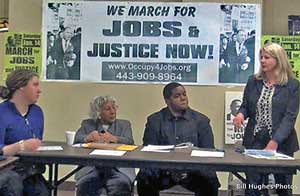
Left to right, Colleen Davidson, Dr. Helena Hicks, Rev. Cortly "C.D." Witherspoon, Sharon Black at the January 4, 2012 press conference announcing the 'March for Jobs.' The activists marched from Baltimore to Washington, D.C. , a photo by Pan-African News Wire File Photos on Flickr.
From Baltimore to Washington, D.C. Jobs marchers plan civil rights walk
By Andre’ Powell
Baltimore
Published Jan 14, 2012 11:00 AM
At a Jan. 4 press conference held at the Workers United Union Hall in Baltimore, representatives of local and national groups announced their plans to hold a “March for Jobs & Justice” beginning in Baltimore on Jan. 14 and ending in Washington, D.C., on Jan. 16, the official holiday honoring the legacy of the Rev. Dr. Martin Luther King Jr.
The march is part of a national call by the Occupy 4 Jobs Network for actions on the King holiday weekend.
Marchers plan to walk 41 miles from Baltimore, which suffers a youth unemployment rate of more than 56 percent, to Occupy Washington, D.C., to underscore the national significance of joblessness and to demand a jobs program.
With Civil Rights veteran Dr. Helena Hicks present, along with representatives of Occupy Baltimore and many others, the group also made a commitment to march from the Union Baptist Church to the historic Read’s drugstore in downtown Baltimore. Organizers state this will constitute the Baltimore leg of the march before proceeding to Washington, D.C.
Read’s was the site of the 1955 Civil Rights sit-ins, led by students, which paved the way to wider actions and other sit-ins. A fight to keep Read’s from being torn down by developers, either outright or through neglect, has begun. Dr. Hicks received several standing ovations by the group for her participation in those early sit-ins. She, along with other senior Civil Rights leaders of that era, will lead the Jan. 14 March for Jobs & Justice.
Rev. Cortly “C.D.” Witherspoon, the 30-year-old president of the Baltimore Southern Christian Leadership Conference, explained the significance of this struggle, and plans to continue the fight to preserve Read’s following the march. He also explained why the group wanted to emphasize the demand for “Jobs, not jails” and how this impacts Baltimore’s youth.
Asher Strauss from Occupy Baltimore explained how the Occupy movement saw the connection with the community and why they were joining the march.
National Action Network representative Marvin “Doc” Cheatham spoke on how the younger activists from the Occupy movement were an inspiration for the fight for justice. He pledged his group’s assistance on that day.
Sharon Black, speaking on behalf of the newly formed Occupy 4 Jobs Network, added that there was a connection between the struggle against racism and for Civil Rights with the struggle for jobs. She referred to the recent study by Scoop Daily which announced that Baltimore was one of the top five worst cities for youth. The criteria included unemployment and incarceration rates. All five cities and regions in the study have the largest concentration of African-American populations in the country. They include Chicago, Atlanta, Detroit, Baltimore and Cleveland.
Black also noted that some of the walkers will remain in Washington for the Jan. 17 Occupy Congress protest.
For those interested in staying in touch after the march for future activities, go to www.Occupy4Jobs.org.
--------------------------------------------
Articles copyright 1995-2012 Workers World. Verbatim copying and distribution of this entire article is permitted in any medium without royalty provided this notice is preserved.
Workers World, 55 W. 17 St., NY, NY 10011
Email: ww@workers.org
Subscribe wwnews-subscribe@workersworld.net
Support independent news DONATE
No comments:
Post a Comment